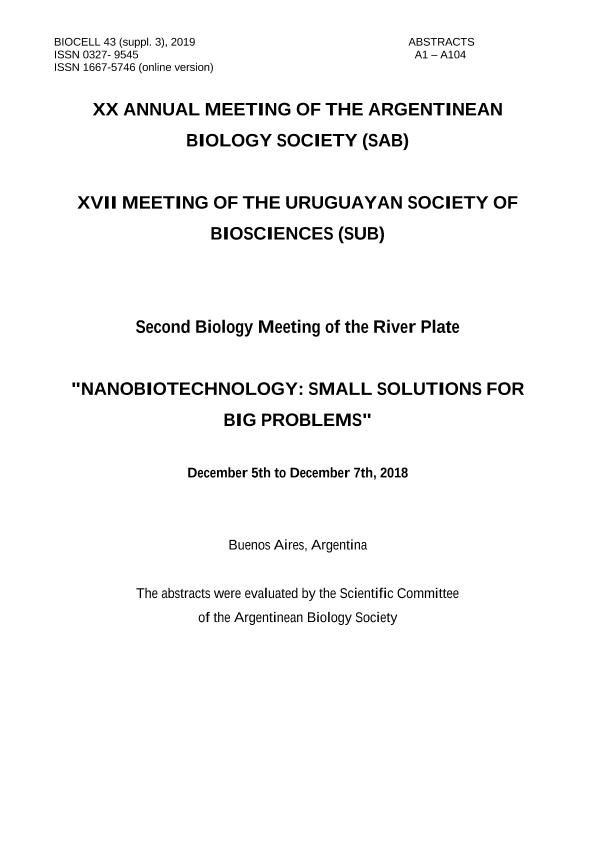Evento
Pacu viscera extract obtained by aqueous two-phase system: potential application in recycling waste
Gomez, Gabriela Noemi ; Acevedo Gomez, Antonella Valeria
; Acevedo Gomez, Antonella Valeria ; Nerli, Bibiana Beatriz
; Nerli, Bibiana Beatriz ; Leiva, Laura Cristina Ana
; Leiva, Laura Cristina Ana
 ; Acevedo Gomez, Antonella Valeria
; Acevedo Gomez, Antonella Valeria ; Nerli, Bibiana Beatriz
; Nerli, Bibiana Beatriz ; Leiva, Laura Cristina Ana
; Leiva, Laura Cristina Ana
Tipo del evento:
Reunión
Nombre del evento:
XX Annual Meeting of the Argentinean Biology Society (SAB) . VII Meeting of the Uruguayan Society of Biosciences (SUB). Second Biology Meeting Of The River Plate
Fecha del evento:
05/12/2018
Institución Organizadora:
Sociedad Argentina de Biología;
Sociedad Uruguaya de Biociencias;
Título de la revista:
Biocell
Editorial:
Tech Science Press
ISSN:
0327-9545
e-ISSN:
1667-5746
Idioma:
Inglés
Clasificación temática:
Resumen
Pacú (Piaractus mesopotamicus) production represents 40% of northeast fish yield. It is of interest to valorize the current disposal of fish processing through the use of viscera waste, source of enzymes such as trypsin. Aqueous two-phase systems (ATPS) have been successfully used for separation and purification of macromolecules because exhibit multiple advantages: good resolution, high yield, low cost and proteins retain their biological activity. The goal of this work was to analyze the partition of pacú pyloric caeca extract in aqueous two-phase PEG-citrate systems. Preparation of crude alkaline extract was made by mechanical and sonic digestion of pyloric caeca. A two-phase system formed by polyethyleneglycol (PEG) 3350 - citrate, pH 8.4, was used and the partition of alkaline proteins of the extract was assayed. Trypsin activity was determined with the substrate a-Nbenzoyl-DL-arginine-p-nitroanilide (BAPNA) and protein content was estimated by the Warburg and Christian method. Partition coefficients (Kp) were calculated by the ratio of enzyme trypsin activity or total protein between phases. The experiments revealed that partition coefficient of trypsin was greater than unity (KpTrip: 2,2), while partition coefficient of total proteins was smaller than one (KpTP: 0,33). This result indicates a tendency for trypsin-like enzymes to concentrate in the top phase (PEG-enriched phase), while proteins were partitioned to the salt-enriched phase (bottom phase). Thus, a high separating capability was verified in the assayed system. On the other hand, X ray plates were treated with the top phase achieving a complete removed of the gelatine layer which covers it, with no interference of PEG. These studies demonstrate the applicability of a simple procedure to obtain a phase enriched with enzymes from pacú viscera extracts and their use in recycling of radiographic plates.
Palabras clave:
PACU
,
VISCERAS
,
WASTE
,
AQUEOUS TWO-PHASE SYSTEM
Archivos asociados
Licencia
Identificadores
Colecciones
Eventos(IMIT)
Eventos de INST.DE MODELADO E INNOVACION TECNOLOGICA
Eventos de INST.DE MODELADO E INNOVACION TECNOLOGICA
Citación
Pacu viscera extract obtained by aqueous two-phase system: potential application in recycling waste; XX Annual Meeting of the Argentinean Biology Society (SAB) . VII Meeting of the Uruguayan Society of Biosciences (SUB). Second Biology Meeting Of The River Plate; Buenos Aires; Argentina; 2018; 33-33
Compartir



